[English] 日本語
 Yorodumi
Yorodumi- PDB-4kfq: Crystal structure of the NMDA receptor GluN1 ligand binding domai... -
+ Open data
Open data
- Basic information
Basic information
| Entry | Database: PDB / ID: 4kfq | ||||||
|---|---|---|---|---|---|---|---|
| Title | Crystal structure of the NMDA receptor GluN1 ligand binding domain in complex with 1-thioxo-1,2-dihydro-[1,2,4]triazolo[4,3-a]quinoxalin-4(5H)-one | ||||||
 Components Components | Glutamate receptor ionotropic, NMDA 1 | ||||||
 Keywords Keywords | MEMBRANE PROTEIN / ligand binding domain / Ionotropic Glutamate Receptor | ||||||
| Function / homology |  Function and homology information Function and homology informationpons maturation / positive regulation of Schwann cell migration / regulation of cell communication / EPHB-mediated forward signaling / Assembly and cell surface presentation of NMDA receptors / olfactory learning / dendritic branch / conditioned taste aversion / regulation of respiratory gaseous exchange / protein localization to postsynaptic membrane ...pons maturation / positive regulation of Schwann cell migration / regulation of cell communication / EPHB-mediated forward signaling / Assembly and cell surface presentation of NMDA receptors / olfactory learning / dendritic branch / conditioned taste aversion / regulation of respiratory gaseous exchange / protein localization to postsynaptic membrane / propylene metabolic process / response to glycine / regulation of monoatomic cation transmembrane transport / voltage-gated monoatomic cation channel activity / Synaptic adhesion-like molecules / NMDA glutamate receptor activity / RAF/MAP kinase cascade / parallel fiber to Purkinje cell synapse / NMDA selective glutamate receptor complex / response to morphine / calcium ion transmembrane import into cytosol / glutamate binding / neuromuscular process / protein heterotetramerization / regulation of synapse assembly / positive regulation of calcium ion transport into cytosol / positive regulation of reactive oxygen species biosynthetic process / glycine binding / regulation of axonogenesis / male mating behavior / regulation of dendrite morphogenesis / suckling behavior / startle response / response to amine / monoatomic cation transmembrane transport / regulation of neuronal synaptic plasticity / associative learning / monoatomic cation transport / social behavior / excitatory synapse / ligand-gated monoatomic ion channel activity / positive regulation of excitatory postsynaptic potential / cellular response to glycine / positive regulation of dendritic spine maintenance / Unblocking of NMDA receptors, glutamate binding and activation / cellular response to manganese ion / phosphatase binding / glutamate receptor binding / long-term memory / regulation of neuron apoptotic process / prepulse inhibition / monoatomic cation channel activity / calcium ion homeostasis / glutamate-gated receptor activity / synaptic cleft / response to fungicide / glutamate-gated calcium ion channel activity / presynaptic active zone membrane / dendrite membrane / ligand-gated monoatomic ion channel activity involved in regulation of presynaptic membrane potential / sensory perception of pain / response to amphetamine / ionotropic glutamate receptor signaling pathway / hippocampal mossy fiber to CA3 synapse / positive regulation of synaptic transmission, glutamatergic / regulation of membrane potential / adult locomotory behavior / excitatory postsynaptic potential / learning / synaptic transmission, glutamatergic / synaptic membrane / transmitter-gated monoatomic ion channel activity involved in regulation of postsynaptic membrane potential / postsynaptic density membrane / regulation of long-term neuronal synaptic plasticity / visual learning / calcium channel activity / regulation of synaptic plasticity / terminal bouton / response to organic cyclic compound / cerebral cortex development / memory / synaptic vesicle membrane / response to calcium ion / intracellular calcium ion homeostasis / neuron cellular homeostasis / calcium ion transport / rhythmic process / synaptic vesicle / signaling receptor activity / presynaptic membrane / amyloid-beta binding / protein-containing complex assembly / chemical synaptic transmission / postsynaptic membrane / response to ethanol / negative regulation of neuron apoptotic process / transcription by RNA polymerase II / dendritic spine / postsynaptic density / learning or memory Similarity search - Function | ||||||
| Biological species |  | ||||||
| Method |  X-RAY DIFFRACTION / X-RAY DIFFRACTION /  SYNCHROTRON / SYNCHROTRON /  MOLECULAR REPLACEMENT / Resolution: 2.2 Å MOLECULAR REPLACEMENT / Resolution: 2.2 Å | ||||||
 Authors Authors | Steffensen, T.B. / Tabrizi, F.M. / Gajhede, M. / Kastrup, J.S. | ||||||
 Citation Citation |  Journal: J.Biol.Chem. / Year: 2013 Journal: J.Biol.Chem. / Year: 2013Title: Crystal structure and pharmacological characterization of a novel N-methyl-D-aspartate (NMDA) receptor antagonist at the GluN1 glycine binding site. Authors: Kvist, T. / Steffensen, T.B. / Greenwood, J.R. / Mehrzad Tabrizi, F. / Hansen, K.B. / Gajhede, M. / Pickering, D.S. / Traynelis, S.F. / Kastrup, J.S. / Brauner-Osborne, H. #1:  Journal: Embo J. / Year: 2003 Journal: Embo J. / Year: 2003Title: Mechanisms of activation, inhibition and specificity: crystal structures of the NMDA RECEPTOR NR1 ligand-binding core Authors: Furukawa, H. / Gouaux, E. | ||||||
| History |
|
- Structure visualization
Structure visualization
| Structure viewer | Molecule:  Molmil Molmil Jmol/JSmol Jmol/JSmol |
|---|
- Downloads & links
Downloads & links
- Download
Download
| PDBx/mmCIF format |  4kfq.cif.gz 4kfq.cif.gz | 141.9 KB | Display |  PDBx/mmCIF format PDBx/mmCIF format |
|---|---|---|---|---|
| PDB format |  pdb4kfq.ent.gz pdb4kfq.ent.gz | 110.8 KB | Display |  PDB format PDB format |
| PDBx/mmJSON format |  4kfq.json.gz 4kfq.json.gz | Tree view |  PDBx/mmJSON format PDBx/mmJSON format | |
| Others |  Other downloads Other downloads |
-Validation report
| Summary document |  4kfq_validation.pdf.gz 4kfq_validation.pdf.gz | 484.4 KB | Display |  wwPDB validaton report wwPDB validaton report |
|---|---|---|---|---|
| Full document |  4kfq_full_validation.pdf.gz 4kfq_full_validation.pdf.gz | 493.4 KB | Display | |
| Data in XML |  4kfq_validation.xml.gz 4kfq_validation.xml.gz | 28.5 KB | Display | |
| Data in CIF |  4kfq_validation.cif.gz 4kfq_validation.cif.gz | 40.6 KB | Display | |
| Arichive directory |  https://data.pdbj.org/pub/pdb/validation_reports/kf/4kfq https://data.pdbj.org/pub/pdb/validation_reports/kf/4kfq ftp://data.pdbj.org/pub/pdb/validation_reports/kf/4kfq ftp://data.pdbj.org/pub/pdb/validation_reports/kf/4kfq | HTTPS FTP |
-Related structure data
| Related structure data |  1pbqS S: Starting model for refinement |
|---|---|
| Similar structure data |
- Links
Links
- Assembly
Assembly
| Deposited unit | 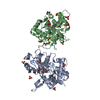
| ||||||||
|---|---|---|---|---|---|---|---|---|---|
| 1 | 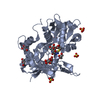
| ||||||||
| 2 | 
| ||||||||
| Unit cell |
|
- Components
Components
| #1: Protein | Mass: 33340.031 Da / Num. of mol.: 2 / Fragment: UNP residues 394-554, 663-800 Source method: isolated from a genetically manipulated source Details: THE PROTEIN CRYSTALLIZED IS THE EXTRACELLULAR LIGAND BINDING DOMAIN OF GLUN1. TRANSMEMBRANE REGIONS WERE GENETICALLY REMOVED AND REPLACED WITH A GLY-THR LINKER (RESIDUES 153 AND 154 OF THE ...Details: THE PROTEIN CRYSTALLIZED IS THE EXTRACELLULAR LIGAND BINDING DOMAIN OF GLUN1. TRANSMEMBRANE REGIONS WERE GENETICALLY REMOVED AND REPLACED WITH A GLY-THR LINKER (RESIDUES 153 AND 154 OF THE STRUCTURE). THEREFORE, THE SEQUENCE MATCHES DISCONTINUOUSLY WITH THE REFERENCE DATABASE (394-554, 663-800) Source: (gene. exp.)   #2: Chemical | #3: Chemical | ChemComp-GOL / #4: Chemical | ChemComp-SO4 / #5: Water | ChemComp-HOH / | |
|---|
-Experimental details
-Experiment
| Experiment | Method:  X-RAY DIFFRACTION / Number of used crystals: 1 X-RAY DIFFRACTION / Number of used crystals: 1 |
|---|
- Sample preparation
Sample preparation
| Crystal | Density Matthews: 2.83 Å3/Da / Density % sol: 56.56 % |
|---|---|
| Crystal grow | Temperature: 279 K / Method: vapor diffusion, hanging drop / pH: 7.5 Details: 1-thioxo-1,2-dihydro-[1,2,4]triazolo[4,3-a]quinoxalin-4(5H)-one was added as solid compound and the solution was gently shaken overnight. 0.3 M ammonium sulfate, 0.1 M HEPES, and 30 % PEG ...Details: 1-thioxo-1,2-dihydro-[1,2,4]triazolo[4,3-a]quinoxalin-4(5H)-one was added as solid compound and the solution was gently shaken overnight. 0.3 M ammonium sulfate, 0.1 M HEPES, and 30 % PEG 4000, pH 7.5, VAPOR DIFFUSION, HANGING DROP, temperature 279K |
-Data collection
| Diffraction | Mean temperature: 100 K |
|---|---|
| Diffraction source | Source:  SYNCHROTRON / Site: SYNCHROTRON / Site:  BESSY BESSY  / Beamline: 14.1 / Wavelength: 0.91841 Å / Beamline: 14.1 / Wavelength: 0.91841 Å |
| Detector | Type: MARMOSAIC 225 mm CCD / Detector: CCD / Date: Dec 18, 2010 |
| Radiation | Protocol: SINGLE WAVELENGTH / Monochromatic (M) / Laue (L): M / Scattering type: x-ray |
| Radiation wavelength | Wavelength: 0.91841 Å / Relative weight: 1 |
| Reflection | Resolution: 2.2→39.69 Å / Num. all: 37896 / Num. obs: 37846 / % possible obs: 99.9 % / Redundancy: 3.2 % / Biso Wilson estimate: 26 Å2 / Rmerge(I) obs: 0.09 / Rsym value: 0.09 / Net I/σ(I): 7.1 |
| Reflection shell | Resolution: 2.2→2.32 Å / Redundancy: 3.2 % / Rmerge(I) obs: 0.392 / Mean I/σ(I) obs: 1.9 / Num. unique all: 5498 / Rsym value: 0.392 / % possible all: 100 |
- Processing
Processing
| Software |
| ||||||||||||||||||||||||||||||||||||||||||||||||||||||||||||||||||||||||||||||||||||||||||||||||||
|---|---|---|---|---|---|---|---|---|---|---|---|---|---|---|---|---|---|---|---|---|---|---|---|---|---|---|---|---|---|---|---|---|---|---|---|---|---|---|---|---|---|---|---|---|---|---|---|---|---|---|---|---|---|---|---|---|---|---|---|---|---|---|---|---|---|---|---|---|---|---|---|---|---|---|---|---|---|---|---|---|---|---|---|---|---|---|---|---|---|---|---|---|---|---|---|---|---|---|---|
| Refinement | Method to determine structure:  MOLECULAR REPLACEMENT MOLECULAR REPLACEMENTStarting model: PDB entry 1PBQ Resolution: 2.2→39.69 Å / SU ML: 0.62 / Isotropic thermal model: Restrained / Cross valid method: THROUGHOUT / σ(F): 1.38 / Phase error: 21.78 / Stereochemistry target values: ML
| ||||||||||||||||||||||||||||||||||||||||||||||||||||||||||||||||||||||||||||||||||||||||||||||||||
| Solvent computation | Shrinkage radii: 0.86 Å / VDW probe radii: 1.1 Å / Solvent model: FLAT BULK SOLVENT MODEL / Bsol: 48.896 Å2 / ksol: 0.376 e/Å3 | ||||||||||||||||||||||||||||||||||||||||||||||||||||||||||||||||||||||||||||||||||||||||||||||||||
| Displacement parameters | Biso mean: 27 Å2
| ||||||||||||||||||||||||||||||||||||||||||||||||||||||||||||||||||||||||||||||||||||||||||||||||||
| Refinement step | Cycle: LAST / Resolution: 2.2→39.69 Å
| ||||||||||||||||||||||||||||||||||||||||||||||||||||||||||||||||||||||||||||||||||||||||||||||||||
| Refine LS restraints |
| ||||||||||||||||||||||||||||||||||||||||||||||||||||||||||||||||||||||||||||||||||||||||||||||||||
| LS refinement shell | Refine-ID: X-RAY DIFFRACTION
|
 Movie
Movie Controller
Controller





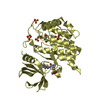
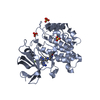
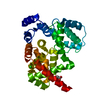
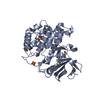
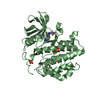
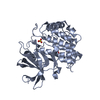
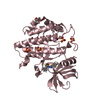
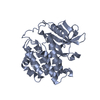

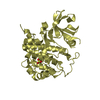
 PDBj
PDBj










